Jedną z kluczowych rzeczy, na których skupiamy się w WPBeginner, jest upewnienie się, że każdy wpis ma przyciągający wzrok obrazek wyróżniający. W końcu wpis bez wyróżniającego obrazka może wyglądać niekompletnie i nieprofesjonalnie.
Wyróżniające się obrazki pomagają Twoim wpisom na WordPressie przyciągnąć uwagę. Sprawiają, że twoja treść jest bardziej atrakcyjna i uzyskuje więcej kliknięć, gdy jest udostępniana w mediach społecznościowych. Bądźmy jednak szczerzy – stworzenie unikatowego obrazka do każdego wpisu zajmuje sporo czasu, a czasami trzeba po prostu szybko opublikować treść.
Właśnie dlatego posiadanie domyślnego obrazka awaryjnego jest tak pomocne. Dzięki temu twoja witryna wygląda czysto i profesjonalnie, nawet gdy się spieszysz.
W tym przewodniku pokażemy ci trzy proste sposoby na skonfigurowanie domyślnego obrazka zastępczego dla twoich wpisów w WordPress. Omówimy zarówno metody oparte na wtyczkach, jak i na kodzie, abyś mógł wybrać to, co będzie dla Ciebie najlepsze.
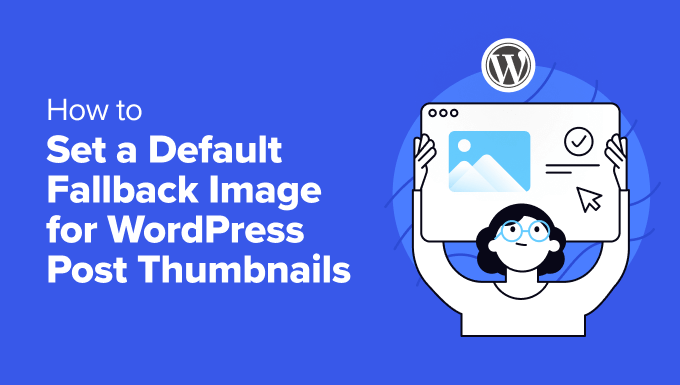
Dlaczego warto ustawić domyślny obrazek wyróżniający w WordPress?
W WordPressie, wyróżniające się obrazki (lub miniaturki wpisów) są bardzo ważnymi elementami wizualnymi, które reprezentują twoją treść.
Przyciągają one uwagę na twoim blogu, w archiwach i w mediach społecznościowych, dając czytelnikom szybki podgląd tego, czego mogą się spodziewać.
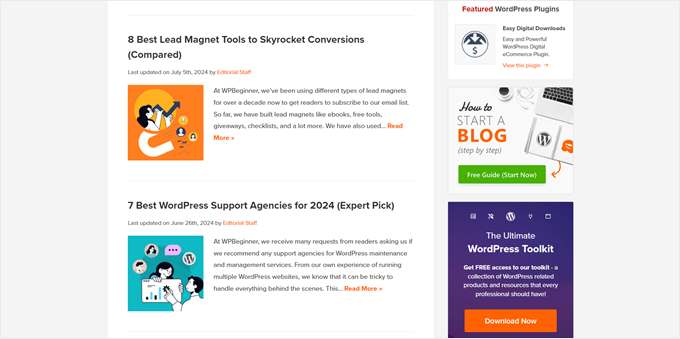
Ale co się dzieje, gdy nie masz tego elementu projektu WordPress dla każdego wpisu? Wtedy właśnie przydaje się ustawienie domyślnego obrazka wyróżniającego.
To rozwiązanie jest idealne dla ruchliwych witryn z wiadomościami, starszych treści bez obrazków lub utrzymania spójnego, markowego wyglądu w całej twojej witrynie internetowej WordPress.
Bez domyślnego obrazka twoja witryna może wyglądać dziwnie. Wpisy bez obrazków mogą wyróżniać się w zły sposób, sprawiając, że twoja witryna wygląda niechlujnie. Może to dezorientować czytelników i sprawić, że twoja witryna będzie wydawać się mniej profesjonalna.
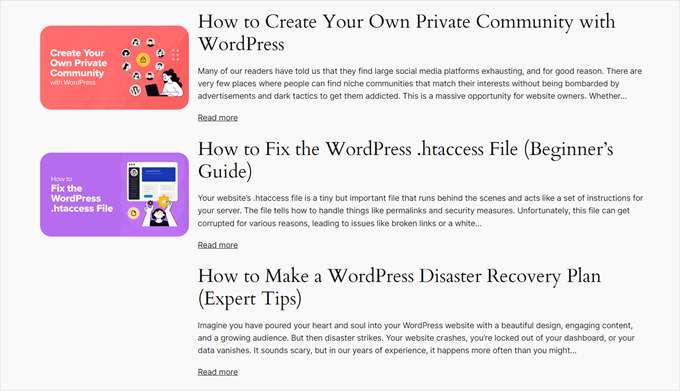
Mając to na uwadze, przyjrzyjmy się 3 prostym sposobom na ustawienie domyślnej miniaturki WordPress dla twoich wpisów. Możesz skorzystać z poniższych odnośników, aby przejść do preferowanej przez ciebie metody:
Metoda 1: Dodanie domyślnego obrazka wyróżniającego WordPress za pomocą wtyczki
Ta metoda jest idealna dla początkujących, ponieważ nie wymaga żadnego kodowania. Użyjemy wtyczki Default Featured Image, aby wyświetlić domyślną miniaturkę wpisu WordPress.
Najpierw zainstaluj i włącz wtyczkę Default Featured Image na twojej witrynie WordPress. Jeśli nie wiesz, jak to zrobić, zapoznaj się z naszym przewodnikiem dla początkujących na temat instalowania wtyczek WordPress.
Po włączaniu, przejdź do Ustawienia “ Media w twoim kokpicie WordPress. Zobaczysz nową opcję “Wybierz domyślny wyróżniający się obrazek”. Kliknij ten przycisk, aby otworzyć twoją bibliotekę multimediów.
Tutaj możesz wybrać istniejący obrazek lub przesłać nowy obrazek, który będzie używany jako rezerwowy dla twoich wpisów.

Po wybraniu twojego obrazka zauważysz opcje ustawienia maksymalnych wymiarów dla domyślnych rozmiarów obrazków wyróżniających.
Możesz je dostosować, jeśli chcesz, lub pozostawić bez zmian, jeśli jesteś zadowolony z ustawień domyślnych.
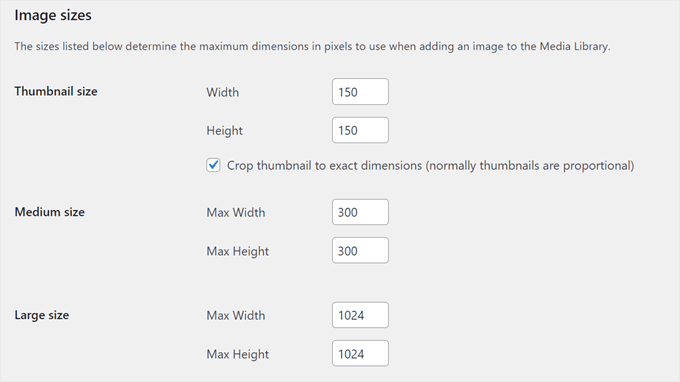
Po zakończeniu przewiń w dół i kliknij “Zapisz zmiany”. Aby zobaczyć twoje zmiany w działaniu, wyświetl podgląd witryny internetowej zarówno na telefonie komórkowym, jak i na komputerze.
Teraz za każdym razem, gdy utworzysz wpis bez ustawienia obrazka wyróżniającego, twoja witryna WordPress automatycznie użyje tego obrazu zastępczego jako miniaturki wpisu.
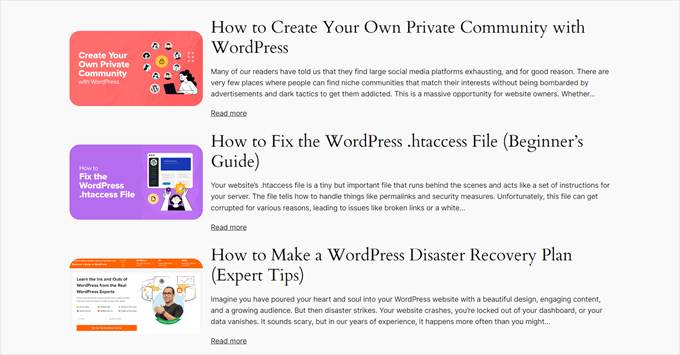
Metoda 2: Ustaw domyślny obrazek wyróżniający za pomocą kodu
Jeśli czujesz się komfortowo z kodowaniem lub wolisz nie używać innej wtyczki, możesz ręcznie ustawić awaryjny obrazek miniaturki wpisu.
Użyjemy wtyczki WPCode, aby bezpiecznie i łatwo dodać tę funkcjonalność.
Najpierw zainstaluj i włącz wtyczkę WPCode na twojej witrynie WordPress. Jeśli potrzebujesz pomocy, sprawdź nasz przewodnik po instalacji wtyczek WordPress.
Po włączaniu, przejdź do Code Snippets “ + Add Snippet w twoim kokpicie WordPress. Wybierz “Add Your Custom Code (New Snippet)” i kliknij “+ Add Custom Snippet”.
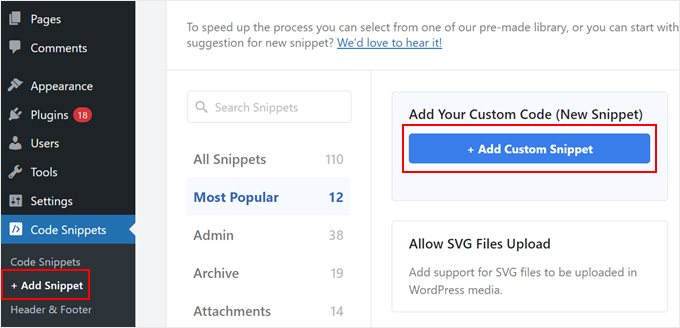
Teraz nadaj swojemu fragmentowi kodu nazwę w stylu “Set Fallback Image for Posts Without Featured Images”.
Zmień również rodzaj fragmentu kodu na “PHP Snippet”.
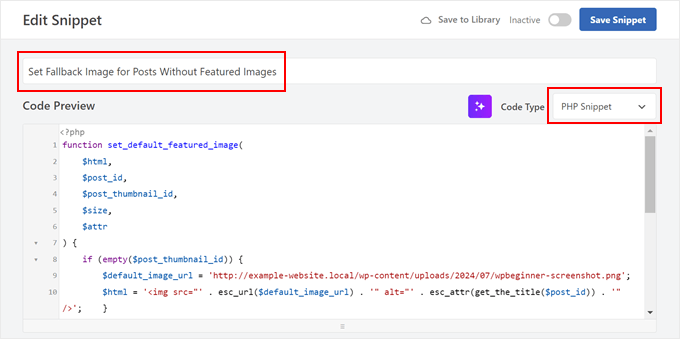
Następnie wklej podany kod w polu Podgląd kodu:
1 2 3 4 5 6 7 8 9 10 11 12 13 14 15 16 17 18 | function set_default_featured_image( $html, $post_id, $post_thumbnail_id, $size, $attr ) { if ( empty( $post_thumbnail_id ) ) { // Replace 'http://example.com/path/to/your/default-image.jpg' with the URL of your default image. $default_image_url = 'http://example.com/path/to/your/default-image.jpg'; $html = '<img src="' . esc_url( $default_image_url ) . '" class="wp-post-image" alt="Default Image"/>'; } return $html;}add_filter( 'post_thumbnail_html', 'set_default_featured_image', 10, 5 );function set_default_featured_image_url( $url, $post_id ) { if ( empty( get_post_thumbnail_id( $post_id ) ) ) { // Replace 'http://example.com/path/to/your/default-image.jpg' with the URL of your default image. $url = 'http://example.com/path/to/your/default-image.jpg'; } return $url;}add_filter( 'default_post_thumbnail_url', 'set_default_featured_image_url', 10, 2 ); |
Ten kod robi dwie główne rzeczy. Po pierwsze, ustawia domyślny obrazek do wyświetlenia, gdy wpis nie ma wyróżniającego obrazka.
Po drugie, zapewnia, że ten domyślny obrazek wyróżniający jest używany konsekwentnie w całej twojej witrynie, w tym w miejscach, w których potrzebny jest tylko adres URL obrazka.
Musisz zastąpić adres URL przykładowego obrazka w kodzie adresem URL twojego wybranego domyślnego obrazka (zobacz wyróżnione części przykładowego kodu).
Jeśli nie jesteś pewien, jak uzyskać adres URL twojego obrazka, zapoznaj się z naszym artykułem o tym, jak uzyskać adres URL obrazków przesyłanych w WordPress.
Po wklejeniu kodu przewiń w dół do sekcji Wstawianie. Zachowaj metodę wstawiania jako “Auto Insert” i zmień lokalizację na “Frontend Only”.
Na koniec przełącz przycisk w prawym górnym rogu na “Aktywny” i kliknij “Zapisz fragment kodu”.
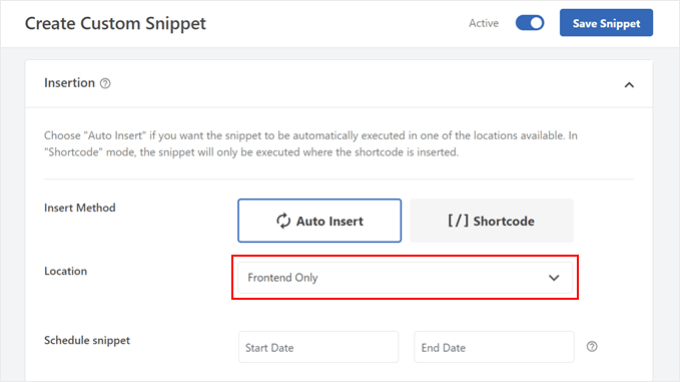
Gdy zobaczysz teraz stronę główną swojego bloga, powinieneś zobaczyć domyślny obrazek pojawiający się dla wszystkich wpisów, które nie mają ustawionego wyróżniającego obrazka.
Metoda 3: Ustaw pierwszy obrazek jako miniaturkę wpisu za pomocą kodu
Ta metoda automatycznie używa pierwszego obrazka w twoim wpisie jako miniaturki. Jest to świetna opcja, jeśli zawsze dołączasz obrazki do swoich wpisów i chcesz zaoszczędzić czas, nie ustawiając obrazków wyróżniających ręcznie.
W tym celu ponownie użyjemy wtyczki WPCode. Jeśli jeszcze jej nie zainstalowałeś, postępuj zgodnie z naszym przewodnikiem dla początkujących na temat instalacji wtyczek WordPress.
Po włączaniu WPCode, przejdź do Code Snippets “ + Add Snippet w twoim kokpicie WordPress. Wybierz “Add Your Custom Code (New Snippet)” i kliknij “+ Add Custom Snippet”.
Na tym etapie możesz nazwać swój fragment kodu na przykład “Użyj pierwszego obrazka w wpisie jako obrazka wyróżniającego”.
Następnie zmień fragment kodu na “PHP Snippet”.
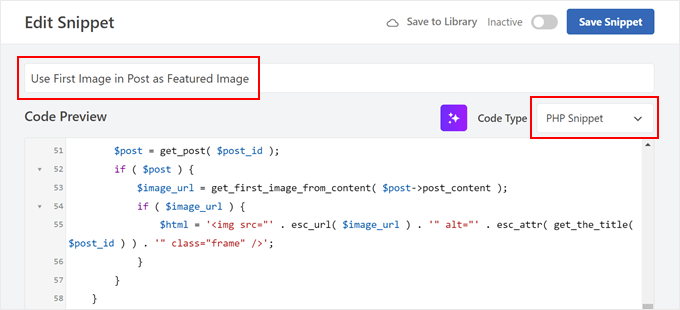
Następnie wklej następujący kod w polu Podgląd kodu:
1 2 3 4 5 6 7 8 9 10 11 12 13 14 15 16 17 18 19 20 21 22 23 24 25 26 27 28 29 30 31 32 33 34 35 36 37 38 39 40 41 42 43 44 45 46 47 48 49 50 51 52 53 54 55 56 57 58 59 60 61 | // Function to get the first image from the post contentfunction get_first_image_from_content( $post_content ) { $dom = new DOMDocument(); libxml_use_internal_errors(true); $dom->loadHTML($post_content); libxml_clear_errors(); $xpath = new DOMXPath($dom); $image_nodes = $xpath->query("//img"); if ( $image_nodes->length > 0 ) { $image_url = $image_nodes->item(0)->getAttribute('src'); return $image_url; } return false;}// Function to set the first image as the featured imagefunction set_first_image_as_featured( $post_id ) { if ( wp_is_post_autosave( $post_id ) || wp_is_post_revision( $post_id ) ) { return; } if ( has_post_thumbnail( $post_id ) ) { return; } $post = get_post( $post_id ); if ( ! $post ) { return; } $image_url = get_first_image_from_content( $post->post_content ); if ( $image_url ) { $upload_dir = wp_upload_dir(); if ( false !== strpos( $image_url, $upload_dir['baseurl'] ) ) { $attachment_id = attachment_url_to_postid( $image_url ); if ( $attachment_id ) { set_post_thumbnail( $post_id, $attachment_id ); } } }}add_action( 'save_post', 'set_first_image_as_featured' );// Function to filter the post thumbnail HTMLfunction filter_post_thumbnail_html( $html, $post_id, $post_thumbnail_id, $size, $attr ) { if ( ! $html ) { $post = get_post( $post_id ); if ( $post ) { $image_url = get_first_image_from_content( $post->post_content ); if ( $image_url ) { $html = '<img src="' . esc_url( $image_url ) . '" alt="' . esc_attr( get_the_title( $post_id ) ) . '" class="frame" />'; } } } return $html;}add_filter( 'post_thumbnail_html', 'filter_post_thumbnail_html', 10, 5 ); |
Mówiąc prościej, ten kod szuka pierwszego obrazka w treści twojego wpisu. Jeśli znajdzie obrazek i nie ma ustawionego wyróżniającego obrazka, to ten pierwszy obrazek staje się wyróżniającym obrazkiem.
Ten kod działa automatycznie za każdym razem, gdy zapisujesz lub aktualizujesz wpis. Ustawia nowy obrazek wyróżniający tylko wtedy, gdy nie jest jeszcze ustawiony, więc nie zastąpi żadnych obrazków wyróżniających ustawionych ręcznie.
Po zakończeniu przewiń w dół do sekcji Wstaw. Upewnij się, że metoda wstawiania jest ustawiona na “Auto Insert”, a lokalizacja na “Run Everywhere”.
Na koniec przełącz przycisk w prawym górnym rogu na “Aktywny” i kliknij “Zapisz fragment kodu”.
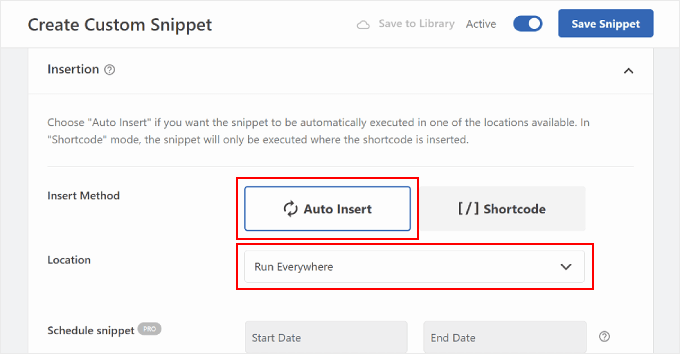
Gdy zobaczysz teraz stronę główną twojego bloga, powinieneś zobaczyć pierwszy obrazek z każdego wpisu jako jego miniaturkę.
Na przykład:
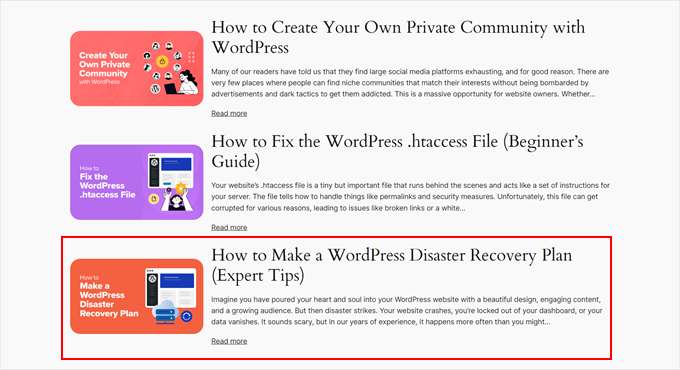
Bonus: Niezbędne wskazówki dotyczące obrazków WordPress
Teraz, gdy dowiedziałeś się, jak ustawić domyślne obrazy zastępcze dla twoich miniaturek wpisów, oto kilka innych przydatnych technik związanych z obrazkami dla WordPressa:
- How to Set a Fallback Featured Image Based on Post Category in WordPress – Pójdź o krok dalej ze swoją domyślną strategią dotyczącą obrazków, ustawiając obrazki zastępcze dla poszczególnych kategorii i dodaj kontekst do twoich podglądów wpisów.
- How to Add an Image in WordPress Sidebar Widget – Dowiedz się więcej, jak wzbogacić swój panel boczny o przyciągające wzrok obrazki, dzięki czemu twój obszar widżetów będzie bardziej angażujący i bogaty w informacje.
- Jak przesyłać duże obrazki w WordPress – Odkryj techniki obsługi dużych plików obrazków bez wpływu na wydajność twojej witryny lub przekraczania limitów przesyłania.
- How to Grayscale Images in WordPress – Dowiedz się, jak dodać stylowy efekt skali szarości do twoich obrazków, idealny do tworzenia spójnego motywu wizualnego lub podkreślania określonych treści.
- Jak automatycznie usuwać domyślne odnośniki do obrazków w WordPressie – Jeśli korzystasz ze starszej wersji WordPressa, to możesz chcieć uniemożliwić twoim obrazkom odnośniki do ich załączonych stron.
Mamy nadzieję, że ten artykuł pomógł ci dowiedzieć się, jak ustawić domyślny obrazek zastępczy dla miniaturek wpisów WordPress. Zachęcamy również do zapoznania się z naszym wyborem najlepszych kreatorów stron typu “przeciągnij i upuść ” dla WordPressa oraz naszym przewodnikiem na temat edycji witryny internetowej WordPress.
If you liked this article, then please subscribe to our YouTube Channel for WordPress video tutorials. You can also find us on Twitter and Facebook.





Muhammed
How do you set up dafault thumbnail for posts that have thumbnails already but the images no longer exist on your server? And these posts are up to 1,000, which were created years ago. And these broken images make your site look messy.
WPBeginner Support
Instead of setting a default featured image in that situation, we would recommend taking a look at our guide below to find the broken images:
https://www.wpbeginner.com/plugins/how-to-fix-broken-links-in-wordpress-with-broken-link-checker/
Admin
Jacques
Hi!
I would like to add a default feature image only to my RSS feeds. Is it possible and how?
Thanks!
Andre Kish
Brilliant stuff – as always – you’ve saved me a ton of time again – THANK YOU!!
Andre
Matus
Great. Just what I needed.
Hum
Hi,
I tried to implement above code in my site with Sahifa theme (it doesn’t have default fallback thumbnail, I guess). However I am not success yet. I just want to display default image if post has no image. Here is the code in template:
<a href="” title=”” rel=”bookmark”>
Where and what code should I add to above to meet my requirement?
Many thanks in advance.
Andrei Filonov
Unfortunately adding condition “has_post_image” may be tricky when plugins are used for “latest” or “related” posts, as we don’t want to mess up plugin code
In this case we can add a custom filter to load custom default image when the_post_thumbnail is called:
You can use it as a starting point and expand if you want custom default images for different post types or categories.
JAVAD
hi i use auto-post-thumbnail to create auto thumbnail
now i want if i enable show excerpt in my theme , first image or featured image shown on above the post in index.php
Siddharth
Great! It is easy to understand now. I have seen different preference of feature images in many different themes but your blog post made sense.
Laura P.
How can I tweak this function for adding a specific image (example.jpg) as the default image for post type: topic? Basically, I’m trying to set a default image for bbpress topic pages.
Thanks!
L
Jose Salazar
Hi!
Im adding the First Post Image as the Default Fallback, but would like to display attachment image ONLY if size in pixels is between 460×350 and 700×525. Is that possible? Any suggestions?
Thanks in advance!
Dee
Hi Jose, How did you get the first image to show up? I removed the echo thumbnail and else statements and only have echo main image but it’s still showing the manual featured image. Thanks
Paal Joachim Romdahl
Hey
Could someone update the above code but this time to be added into the functions.php file?
Perhaps even add on to how to define various category post images.
Thank you!
Nestor Cheese
Works great, thanks! The thing, though. is that the default thumbnail links automatically to the post but if you add a featured image, it doesn’t link. Has anyone resolved this?
Chandra
Is this possible to display as slider from the single post uploaded images…
wfriley
I pasted the code into the functions.php file and checked my site to make sure nothing went haywire. For some reason my posts are now ending up on my static home page. I removed the code but it did not correct the problem. Any chance you might know a fix for that? I tried recreating the home page but the same thing happens.
Alexandre Michel
Hi, looks like it’s working but in my single post page the default image does not show up. It returns blank code. Would you happen to know why?
Mitch Larouche
How can I do an if statement where if there is no FEATURE or no MEDIA image then show google ad? This works but I want to add and IF for when I add a media image also. So if there is NO media image or feature image INCLUDE the adsense…php ad.
?php if( has_post_thumbnail() ) { ?>
?php } else { ?>
?php include(‘adsense_singlepost_top_square.php’) ?>
?php }
Can’t see to figure out how to include the media file from the post?
Dennis
How can i add a default image for woocommerce products?
Chetan Patel
Hello I have Wallpapers site on wordpress. I have little problem with images. Google Indexing my thumbnail instead of full size images. I want to index only full size image. Any way to do this. ?? please help ,me.
Doop
This is great except if you upload an image to a post and then decide to delete it, it will still be attached to the post.
darkpollo
Will this work with external images too? Or only with the ones hosted on the same domain?
Thank you
Byron
Hi,
I’m tying to set a default image for one of my custom post types. I’ve not been able to do this and have tried many of the plugin on the WP repository… Default featured image sets a featured image to All post types even Ubermenu.
I need to limit this to one post type. Do you have any suggestions for me please?
WPBeginner Support
Byron, does the custom post type you want to set the default thumbnail for has featured image support? If yes then using this code in your theme template should display the default post thumbnail.
<?phpif( has_post_thumbnail() ) {the_post_thumbnail();}else{ ?><img src="<?php bloginfo('template_directory'); ?>/images/default-image.jpg"alt="<?php the_title(); ?>"/><?php } ?>1-click Use in WordPress
Admin
Paul
Okay, that didn’t work…! The a href tag messed it up. How do I show you code?
<a href="" title="" >
Try that!
Paul
Oh dear, Let me know how I can show code and I’ll show you what I mean! Thanks, Paul
WPBeginner Support
try wrapping it in
[php] [/php] or [html][/html]Admin
Alejandro
Excellent solution. Now, how I can use this to assign to a specific category and taking ramdom images from a folder?
<img src="/images/default-image.jpg” alt=”” />
Thank you a lot!
WPBeginner Support
This requires a more complicated solution. First you would want to set an image for each category and upload them to a specific folder probably using category slug as the image file names. Then you need to get the category slug for each post and use it as the fallback image URL.
Admin
Konstantin
I am having a small problem, when calling the image, it only shows the full image, not the ones I try to specify (small, medium, thumbnail, etc).
Did anything change in wp3.7+? The images are there, and are being created, but they wont display
Thiago
Thank you!!
Arthur Okonkwo
please is there a plugin that can do this, cos i don’t want to mess with with my code.
WPBeginner Support
We have not tried it yet but you can give Default Featured Image a try. Let us know how it works out for you.
Admin
Mahmod A. Issa
You can keep a backup of your file in case you may mess up with your code, but this way is a good way to keep a default image to a client!
Susan Clifton
Will this work with a custom post type? I’m building a Portfolio theme. Your tutorials are always so helpful. I don’t really know PHP but I’m comfortable with messing with it.
Editorial Staff
Yes this should work just fine.
Admin
Tania
Is there a way to show a default “image not available” image when the source image src is empty ?
I’m promoting amazon products in my blog (using API) but most of the products do not have image. By providing a default “image not available” image, I can help my visitors to understand that the sellers do not provide any image.
I prefer html, css or javascript solution.
thanks and sorry about my english
Editorial Staff
The second option should work for you then. Just upload the image that says image not available.
Admin
Waheed Akhtar
Hi Balkhi,
I have some old posts where post thumbnail is not defined. Also may be for some posts there’s no image uploaded (did it manually through FTP and linked in the post). The result is I don’t see any featured thumbnail for the post.
Is there a way we can grab the first image, resize it (e.g. 200 x 200) and show as featured image?
Thanks.
Editorial Staff
Waheed, what you are looking for is a bit tricky. You would have to parse the src element in each image tag, and make local copies of those. I do remember someone mentioning this plugin a while ago:
http://wordpress.org/extend/plugins/add-linked-images-to-gallery-v01/ << Note: it hasn't been updated in a while. However, it is worth a try. -Syed
Admin
Amin
Thanks for this post. I’ve been searching for days to find a way to have an automatic default featured image. This saved me so much time! Thanks a lot.
Amin
You can also try the Default Thumbnail Plus plugin. Works very well, and no coding necessary!
James
I’ve tried to merge both options but failed.
How would you Check for Thumbnail, but if none then check for First Post Image, but then if none then post Default Branded Image?
Rory
Hi, have you found a way to do this? I’m still on the hunt for an answer, thanks.
Editorial Staff
Try this:
functionget_fbimage() {if((function_exists('has_post_thumbnail')) && (has_post_thumbnail())) {$src= wp_get_attachment_image_src( get_post_thumbnail_id($post->ID),'','');$fbimage=$src[0];}else{global$post,$posts;$fbimage='';$output= preg_match_all('/<img.+src=[\'"]([^\'"]+)[\'"].*>/i',$post->post_content,$matches);$fbimage=$matches[1] [0];}if(empty($fbimage)) {$fbimage=//Define Default URL HEre;}return$fbimage;}1-click Use in WordPress
Admin
Vanessa K
Hi :), great tutorial. I’m a somewhat beginner for a lot of wordpress code. I tried to follow this tutorial for setting up the fall back image a few months ago and failed :p but was able to successfully implement it just now. Yay me! haha. However I would really like to set it up in the way James mentioned…
“How would you Check for Thumbnail, but if none then check for First Post Image, but then if none then post Default Branded Image?”
Posting the code you offered in response to his request is only showing up with syntax errors for me in my functions file :/. I’m sure it’s me and not the code :p but any suggestions? Thanks! And Happy Thanksgiving!
jfwebdesignstud
wp_get_attachment_image_src( get_post_thumbnail_id( $post->ID ), ‘full’ );
can this be used somehow with this for including pinterest featured image
wpbeginner
@jfwebdesignstud You can most certainly specify your thumbnail as the image for Pinterest.
CharlesUibel
Yes But I don’t want to just display the fallback image, I want to assign the image to permanently be the featured image.
wpbeginner
@CharlesUibel http://wordpress.org/extend/plugins/default-post-thumbnails/ << This plugin can do it for you
masoudgolchin
great tutorial , thanks !
DirTek
Great tutorial, mate. Been useful for my “related posts” section. Cheers!
leitseitenmacher
how do you create a real fall back thumbnail?
with the solution a post rhumbnail is shown but therefore not registerate in the backend.
any solution
wpbeginner
@leitseitenmacher The whole idea of a fallback is to show when nothing is selected at the thumbnails area in the backend… so NO you will not be able to see it in the backend….
leitseitenmacher
@wpbeginner
well i allready noticed that.
but the question was: is it possible in wordpress to register a standard post thumbnail via php code so you can see it in the backend?
leitseitenmacher
@wpbeginner
don’t believe the hype.
it#s possible as always check out this remarkable plugin.
http://wordpress.org/extend/plugins/default-post-thumbnails/
wpbeginner
@leitseitenmacher Great find. Again, there is no HYPE that we are trying to create. It is impossible to keep track of what exists in the plugin sphere of WordPress because there are thousands.Just tested out that plugin… It doesn’t register those thumbnails in the database of each post. It is just hooking and giving you a visual display of what you selected in the plugins setting.
If that is what you want, then sure.
The article above accomplishes exactly the same thing without going the extra lengths of visually displaying. In most sites the fallback is usually the site logo. So you don’t really need to see it. But we will do a writeup on the plugin you found. Thanks for the suggestion
gal1982
Excellent solutions, i was looking for that for a while
Is there a way to change the resize the image?
I have tried for example:
$image=wp_get_attachment_image($num, ‘medium’);
But it doesn’t effects the image size. any idea?
Shakir
I have same question. Size attribute does not affect.
Editorial Staff
You have to use Regenerate Thumbnails and add new image sizes.
Admin
milohuang
Nice tutorial. Have test the first method but it did not seem to work. Check the HTML and the default thumb does not exist (no img tag was found). However, if I use the Default Post Thumbnail plugin, it works. Any help? Running 3.2 locally. Thank you!
sebastianjthomas
Great! But how do you set the main_image size without CSS (which stretches the image)
wp_smith
Hello,
I have written a plugin, <a href=”http://wpsmith.net/go/genesis-featured-images”>Genesis Featured Images</a>, that will do this for the <a href=”http://wpsmith.net/go/genesis”>Genesis Framework</a>. I’d love to hear your thoughts!?
sleepingsun
Hello !
Thanks a lot for this useful tip. How would I make the same function to work in RSS feeds please ? If a post thumbnail has been set : use it, otherwise : use the first image attached to the post.
Any help would be much appreciated !
Ayman Aboulnasr
Thank you very much for the tutorial. I was actually thinking about this trick for a few days now.